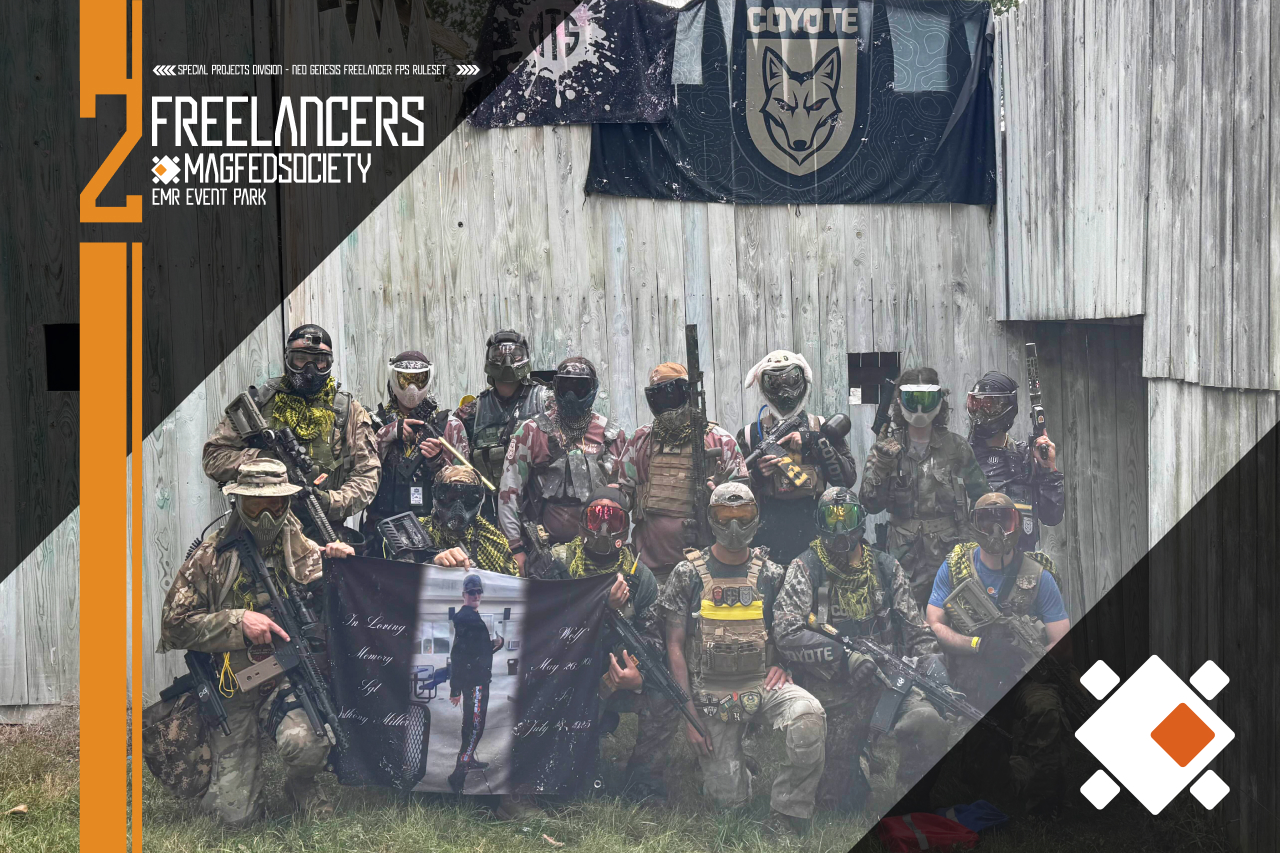
Editorial by Courtny Cotten | Commander, Coyote Force
Everything dropped. I snatched up my submachine gun, grabbed two mags, and sprinted with Rabbit to the central building. There, in the corner of the castle, stood a shielded player emblazoned with the One Shot One Kill logo, shouting as defenders we knew had been wiped filtered out behind us.
First Strike rounds whizzed past as chaos erupted: shields banging on walls, orders yelled from every direction, and the sudden realization that the united forces of Red and Blue were now hammering at our door.
This was the defining moment of Freelancers II - where strategy, intensity, and the spirit of MAGFED came to life. Join me as we dive into the full story of a weekend that tested every player and turned a niche game into an unforgettable adventure.
Our journey to the event was no small feat. With team members driving in from as far as Wisconsin, Illinois, Kentucky, Indiana, and Northern Michigan. Despite the long haul, everyone was eager and the anticipation was high. We had a place to stay close to the field and plenty of good things we'd heard about the venue, but you never quite know until you see it yourself.
Rolling into the field for the first time, the atmosphere struck us right away. Nestled deep in the Pennsylvania mountains, the field had a rustic, old-world charm. We saw those stone-lined fences built from found stone, which added a really unique touch. Plus, the landscape was full of dense foliage and winding paths, giving it a sense of wilderness that we couldn’t wait to dive into.
Meeting the field owner, Tim Hanley and the event organizer Justin Schaefer added a personal touch, and we got a quick orientation on how Saturday would unfold. We also ran into familiar faces from the MAGFED community like Creepshow, the OneShotOneKill (1SOK) folks, and the_prophetwolf, all of whom made us feel incredibly welcome. It was a great start.
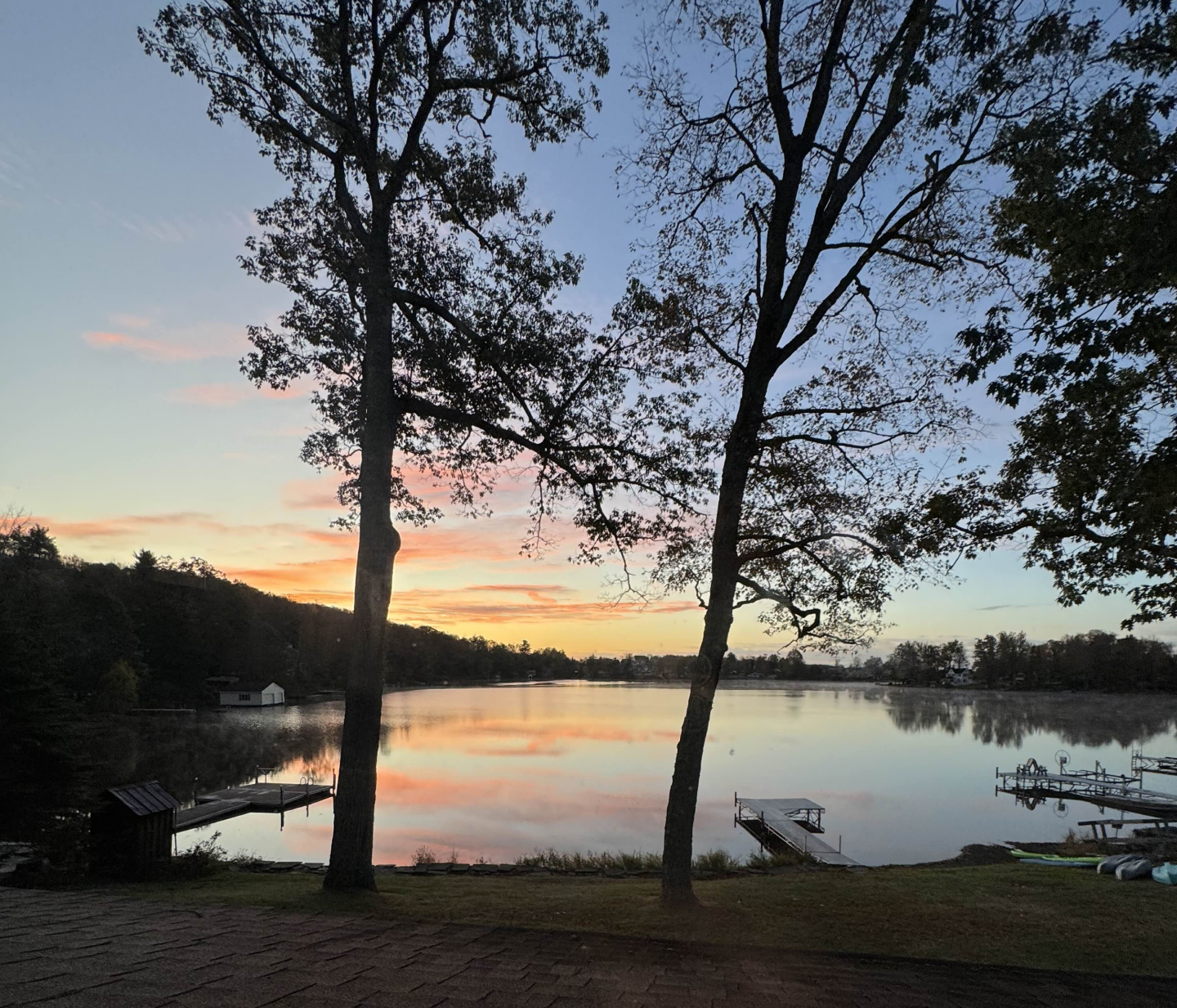
Before we even stepped onto the field, the level of organization shone through. Our event organizer, Justin Schaefer, set a high bar in terms of communication and preparation. Having gotten back into MAGFED years ago thanks to the Magfed Society's well-defined ruleset, I was thrilled to see that same level of detail here. Justin is not only a great organizer but a bit of a lore master, bringing the storyline to life and ensuring the event wasn’t just a force-on-force skirmish, but a strategic, immersive experience.
From the start, the pre-game communication was exceptional. We had a clear ruleset well in advance, including specifics on weapon classes and roles. When there were last-minute changes, like the decision to allow more shields per team, everything was communicated transparently. That level of professionalism and care is rare in the paintball world, where some events can feel like last-minute money grabs. Justin’s approach really set a quality bar that other event producers should aspire to.
Another standout moment was the flexibility around the First Strike rounds. Justin worked with Ben Larson at First Strike to produce a custom color round just for this event. The black on black rounds were incredibly cool. This was a First Strike-only game, but when the supplier’s quality control fell short on the black on black colorway, the organizers pivoted to a different colorway. They ensured players had reliable paint instead of taking chances, and even handed out free rounds from the rejected batch as a bonus. It was a testament to their commitment to a top-tier player experience.
Field Prep and Operations: A Field Owner’s Perspective
As a field owner myself at Coyote Airsoft and Paintball, I’m naturally a tough grader on field operations. I paid close attention to how EMR Event Park was run. Tim Hanley, the owner, did a fantastic job of being welcoming and accommodating to the MAGFED community. He made sure our campsite was in a good spot, especially since we’d reserved an RV space, and overall was very receptive to player needs.
That said, I did notice one area that could be improved from a field operations standpoint. With all the pre-order items like extra microfibers, patches, and the First Strike rounds themselves, registration got a bit congested. One pro tip I’d offer is to segment player orders ahead of time and maybe shift some of that pickup process to Friday evening. That way, on Saturday morning, the staff can focus on the hectic tasks like chrono checks and field safety. Overall, Tim and his team did a solid job, and just a little fine-tuning there could make the player experience even more seamless.
Now let’s dive into the actual gameplay and how the first day unfolded. This event was the second entry in the Freelancers game series, and it had a really cool underlying lore. Each of the three factions: Red (TITAN) commanded by GHOST and the New York Savage Beasts, Blue (PROTEUS) commanded by Creepshow and the OneShotOneKill (1SOK) team, and Yellow (IO AUTOMATION) led Joshua Savoie and the Spectre Magfed Lordz crew - was fighting to control an automated AI called the MAG-9000.
Our faction, a coalition called IO (Input/Output Automation), had a unique role. We weren’t there to “win” in the traditional sense; we were the defenders of the AI, essentially the control faction trying to stop the other two teams from achieving their objectives. It was a cool twist because we got to be the lore-driven “gatekeepers,” making sure no one had an easy path to victory.
The map was set up with southern spawns for each faction and alternate northern spawns that the organizer could activate to keep the gameplay balanced. If one team started camping another’s spawn, it wasn’t a smart move because the other team would just start spawning from the north. This dynamic kept everyone on their toes and allowed the organizer to shift pressure and keep the gameplay intense.
The core objective was straightforward: each faction had to retrieve an item from a northern beacon and deliver it to a central castle defended by us, the IO faction. It was simple, clear, and let everyone focus on combat without overcomplicated rules. This “less is more” approach meant the referees could focus on safety and fair play rather than juggling complex mechanics. The chronographing process was also smooth and efficient, so everyone was firing at safe velocities and gameplay stayed fair.
As day one kicked off, our main focus was to make sure the Red and Blue factions felt real resistance as they moved north toward their beacons. We didn’t want them just strolling in and grabbing their objectives without a fight. Our team took on the responsibility of holding the eastern side of the map, which included a steep hillside and a ridge line with sparse fortifications and stone fences for cover.
We ended up facing off heavily against the Blue team, commanded by our friends from OneShotOneKill and Creepshow. It was a blast, literally and figuratively, to dive into those wooded battles. Coming from the Midwest, our team is used to dense woods, so this kind of terrain played right into our strengths. We spent most of the day out in the brush, engaging with Blue and eventually skirmishing with Red as well. It was an intense day of firefights in the woods, and we loved every minute of it.
If day one was all about skirmishing in the woods, day two turned the intensity up to a whole new level. The second day brought a major shift in the gameplay dynamic: Red and Blue finally joined forces. We’d anticipated this alliance might happen sooner, but it wasn’t until about an hour into day two that we saw Blue and Red truly working in tandem.
Once we noticed mixed groups of Blue and Red players operating together, especially in coordinated shield walls, we knew we had a real challenge on our hands. They began coming at the castle in waves, gathering their forces and then surging forward like a united army. It felt like a scene from a historical siege, with our team sweating bullets as they flung themselves at our walls.
Despite losing our primary command channel radios at one point, our Yellow coalition held firm. We switched to direct communication, moving among our players on foot, keeping everyone informed and ready for the next assault. Eventually, the combined Red and Blue force managed to breach the northwestern wall of the castle, turning the upper and lower levels into a fierce battleground. At one point, the Blue team was just ten feet from their objective, fighting like a hornet’s nest to break through. It was an absolutely exhilarating and nerve-wracking experience for everyone involved.
When things heated up, our very own Terry "FAIRPLAY" Lee even delivered pizza to the Castle to share with the Red & Blue teams!
In the end, we managed to push them back and clear out most of the resistance with about 45 minutes left in the game. A special highlight was seeing Creepshow sneak into the castle multiple times as a commander, making a real impact on the front line. It was a day full of intense combat, teamwork, and unforgettable moments.
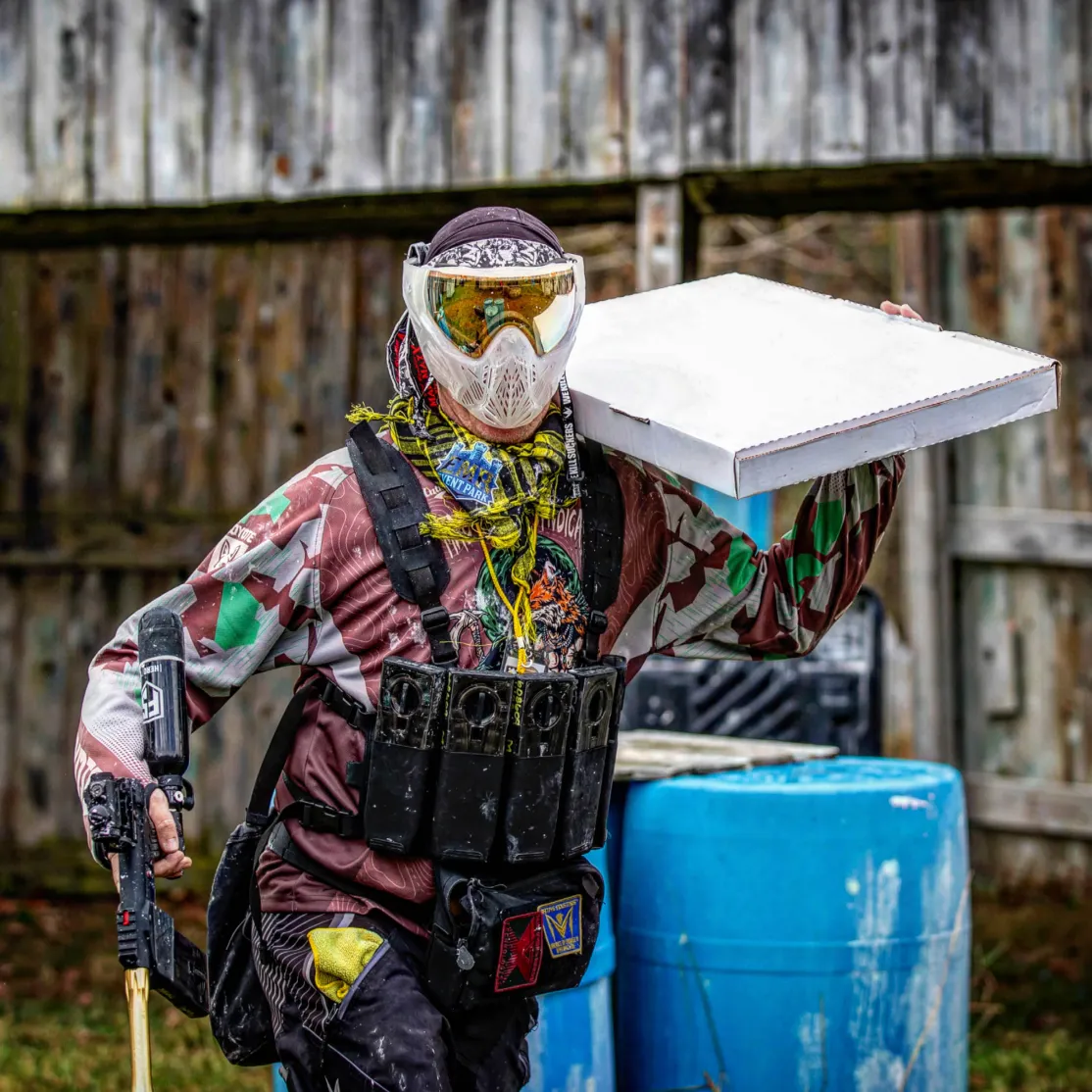
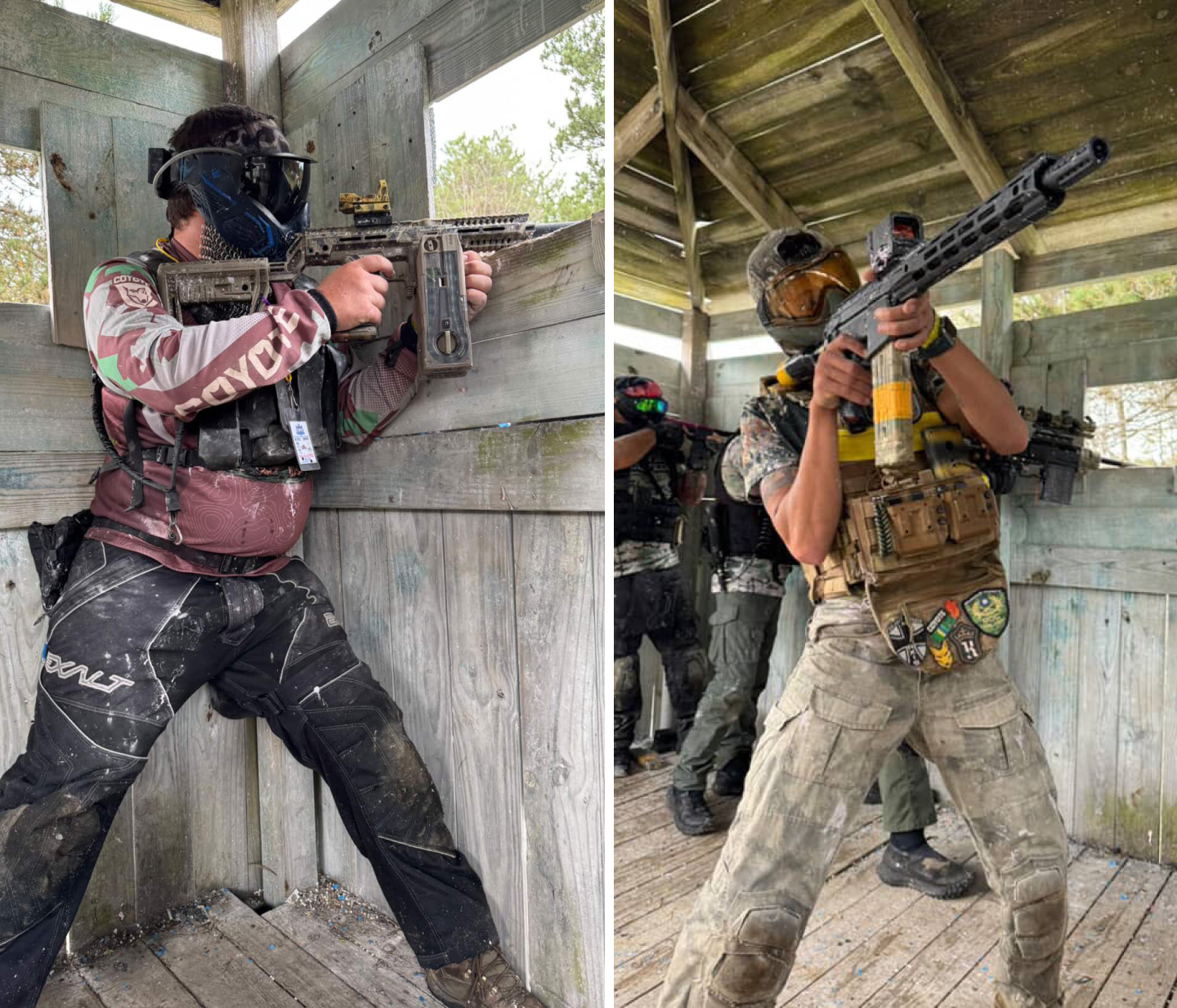
One of the biggest highlights of Freelancers 2 was the continuous gameplay. No long breaks. No resets. Just sustained, evolving conflict. This style of game gets a massive upvote from me because it demands endurance, awareness, and adaptability. Not just from players, but from commanders as well. It also tests all Commanders, Team Captains, and the entire team endurance. Their leadership skills and true gravitas are brought to the fore. Where false bravado provides a spark, it does not have longevity to burn across a long game. Anyone can play for a 2 hour session. Very few can stay on the field non-stop for seven hours straight. It is truly Ironman mode, and it was one of my favorite components to the weekend. Some people like it hardcore.
When the game never really stops, every decision matters. Do you send out a strike team of 6-8 to hammer the enemy and break their ranks, while depleting their energy and ammunition? Or do you keep them fresh for a fiery assault at a later time? Resources, both material and physical are limited in games like this and commanders must manage that.
Ammo consumption, player rotations, communication, and resupply suddenly become real challenges to manage. You don't need more objectives, because keeping your team playing and involved IS a massive challenge. It forces leaders to think like actual field commanders not just about tactics, but about logistics and sustainability over time. That’s the kind of gameplay that pushes the boundaries of what MAGFED can be.
It’s not “easy” or “medium.” It’s appropriately difficult for a format that prides itself on realism. This is what brings us closer to the intensity of true milsim operations: the chaos, the fatigue, and the reward of seeing your team adapt under pressure. Continuous play keeps you immersed in the story and the moment, where the line between game and mission starts to blur in the best possible way.
Yellow coalition pulled weight all weekend. It was great to fight alongside the Midwest Magfed teams for once, versus splitting into opposing factions. Iron sharpens iron, and we were able to test our mettle together! These teams deserve special recognition who we fought beside and shared in victory with:
As we wrap up this event recap, it’s worth reflecting on what made this experience so special. MAGFED is a niche within paintball, and paintball is a niche within the broader world of recreational sports. Having seen the scale of the Euro SuperGame in Poland, with 1500 players, it’s clear that large-scale operations can set a high bar. But this event underscored something equally important for our community here in the US: the value of a well-organized, story-driven, and welcoming atmosphere.
Justin Schaefer (Magfed Society) and the entire event team did a phenomenal job of balancing a niche gameplay style with a friendly and inclusive environment. They created a space where a passionate community could come together to play hard, enjoy the lore, and stay safe thanks to a dedicated referee crew. Their professionalism ensured that even as the action heated up, we could trust in the structure and the spirit of the game.
In a niche like MAGFED, these events are the lifeblood of the community. They keep MAGFED from dying, and hope to usher in a new Golden Era. While we may not have the sheer numbers of a European mega-game, we have something just as valuable: a tight-knit, dedicated group of players and organizers who bring their best to every match.
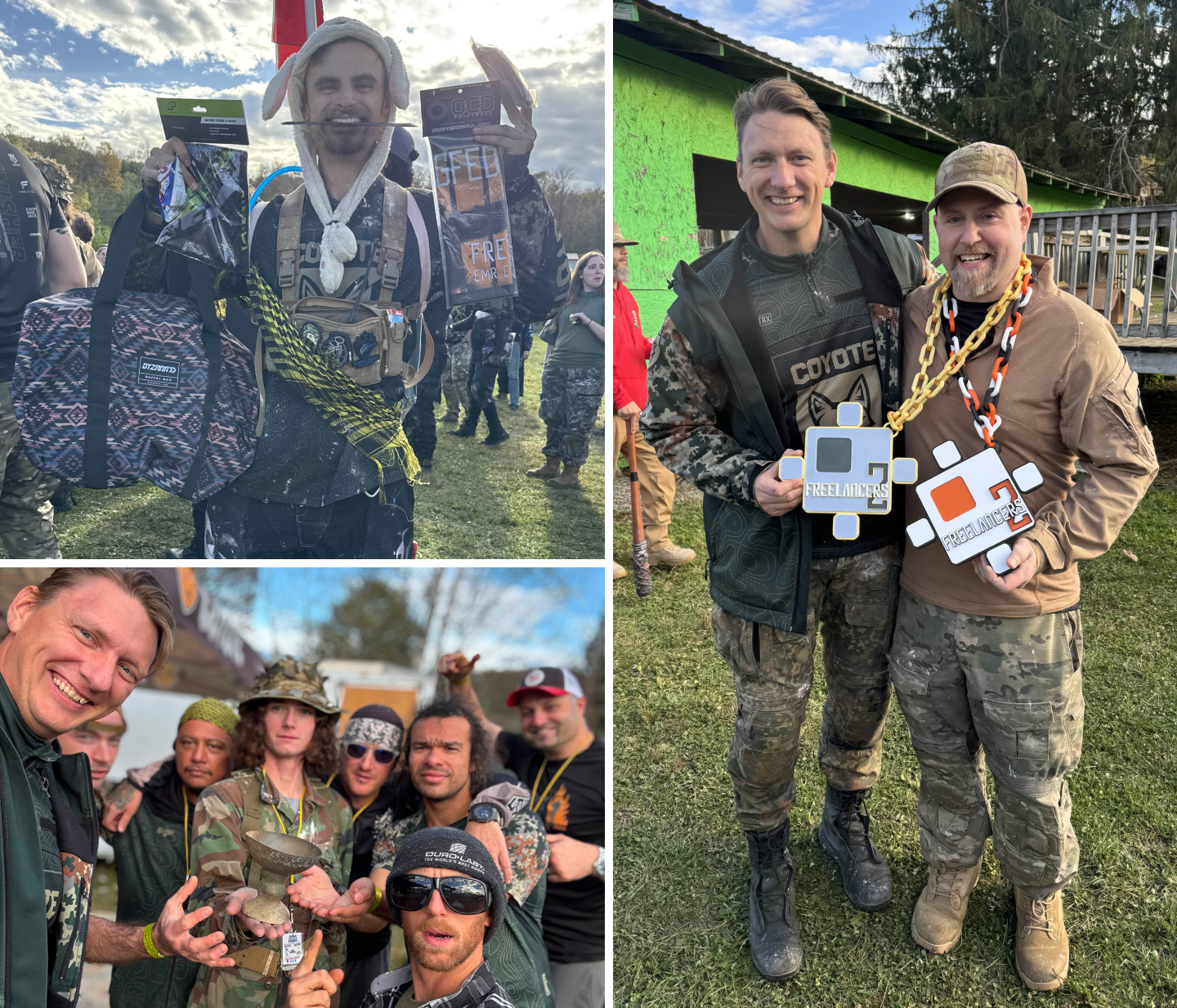

I want to be sure to thank the men (and woman) who made Freelancers 2 special.
To our Coyote Force roster, thank you: